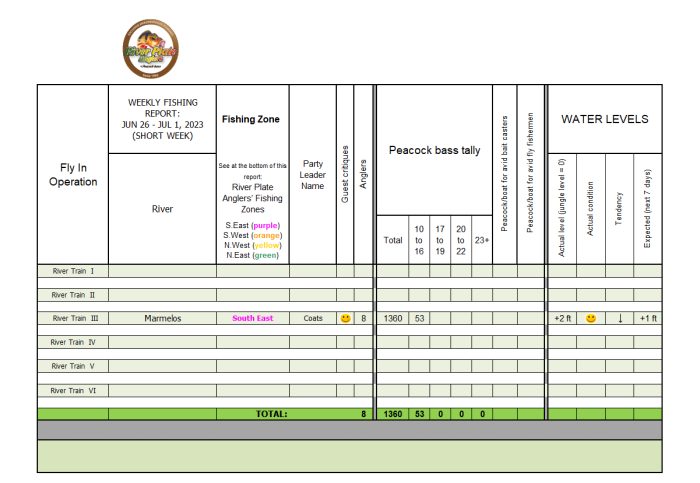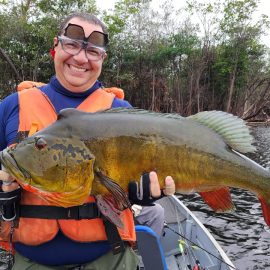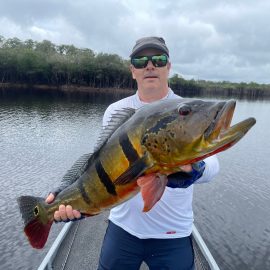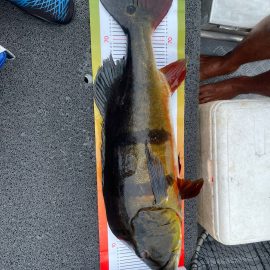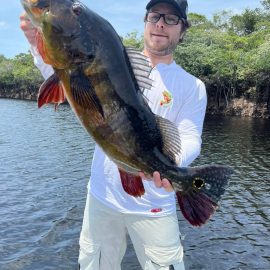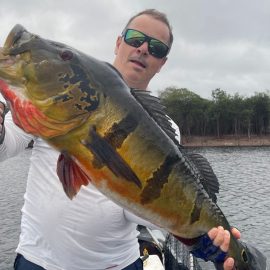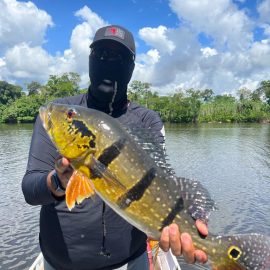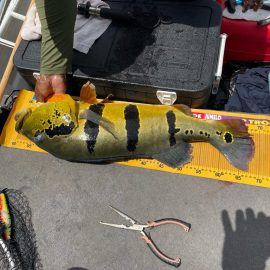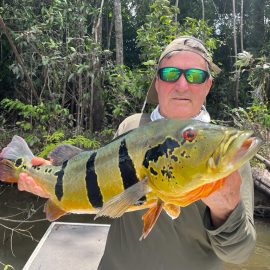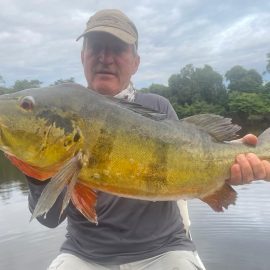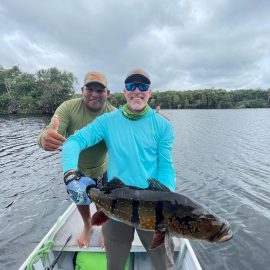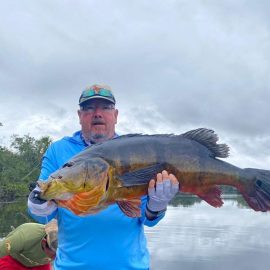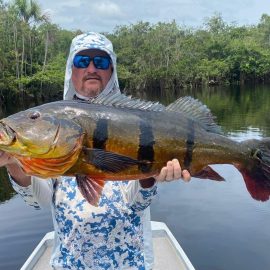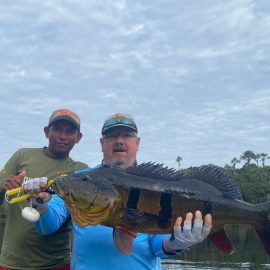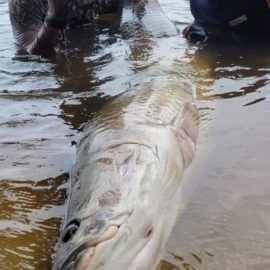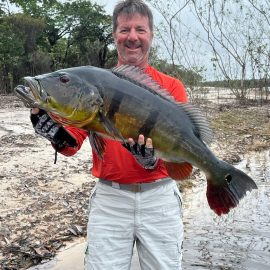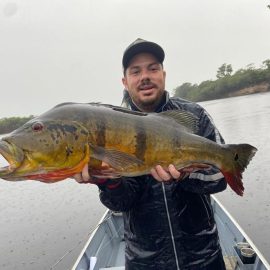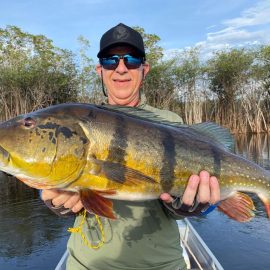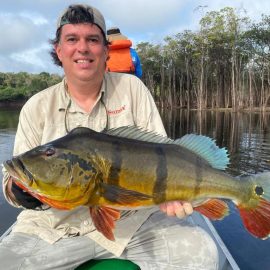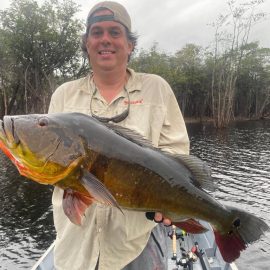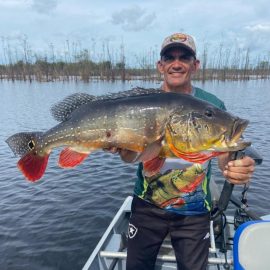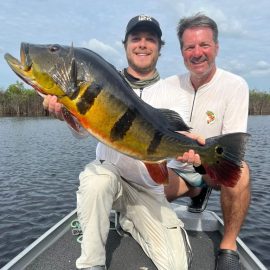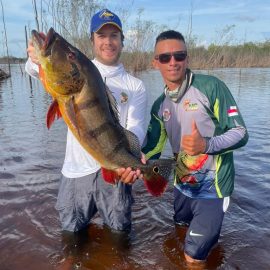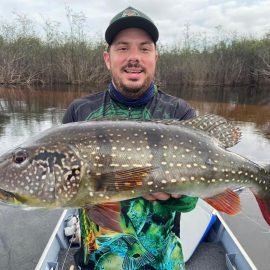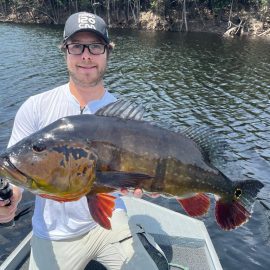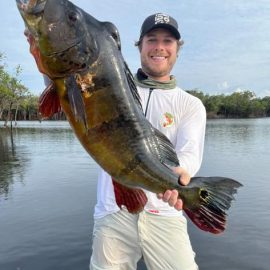Fishing Reports
FR: June 26 – July 1, 2023: Week 1
Jump Starting the 2023/24 Season!
Breaking waters
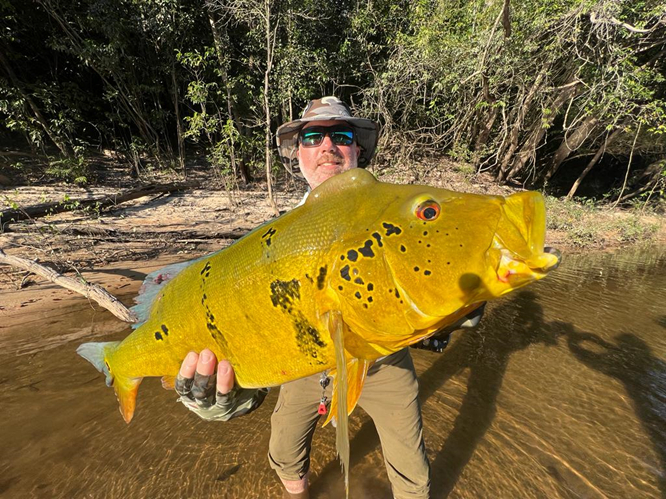
We kicked off our fishing season in the Marmelos with the Coats party from the US, who managed to boat 1,360 Peacocks in their short week trip (4 ½) days. Other exotic species were left out of the fishing tally.
Weather: The region is experiencing less rainfall than the historical average, meaning that the water levels are in optimum condition. La Nina is finally receding, and the Amazon basin is steadily coming back to normal. All water systems in our South East Zone are forecasted to have little to no rain for the next 2 weeks. See below the 3-month Rain Anomaly Forecast.
Groups: 1
Anglers: 8
Peacock Bass Caught: 1360
Biggest: 14lbs
Over 10lbs: 53
3-Month Rain Anomaly Forecast In Our Four Fishing Dry Zones
(Valid for June-July-August)
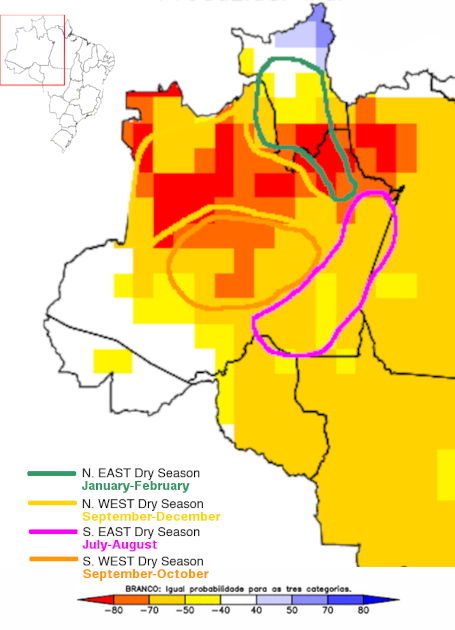
Source: CPTEC/INPE, Brazil
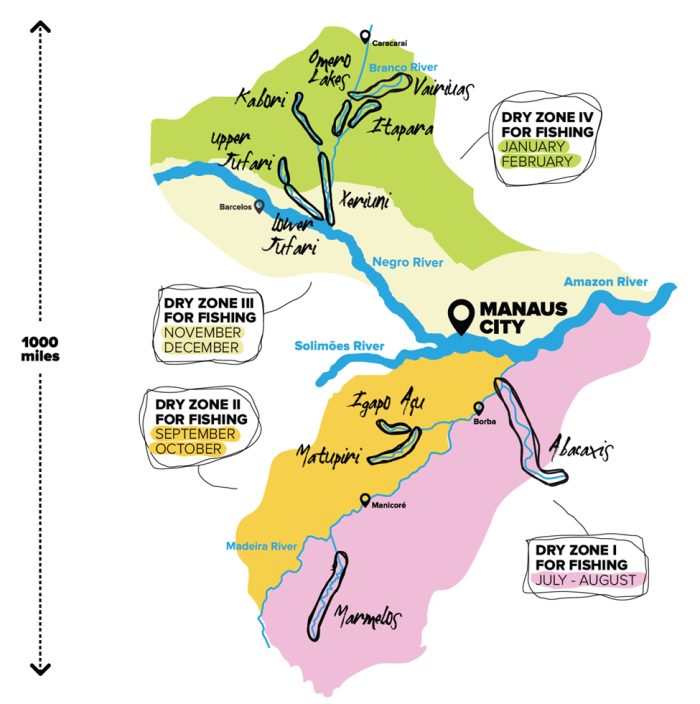
FR: October 29-December 17, 2022: Week 15,16,17,18,19 & 20
LA NIÑA IS MAKING IT TOUGHER FOR EVERYONE IN THE AMAZON BUT…
Our North Eastern Zone May Save The Season
We have seven River Trains concentrated in this zone.
Stats: Despite the many river basins River Plate controls across 1,000 miles by 500 miles, it has been difficult to maintain our high fishing standards during the last six weeks. Typically, a party of eight River Plate anglers would catch 700 to 1,000 peacocks, or more, with four percent of those fish weighing more than 10 lbs with a couple of +20 pouders. That’s in addition to a variety of other tropical fish. Unfortunately, thanks to La Niña and the high water levels it has created, some of our anglers have been catching 1/3 of the number of fish we are usually able to put them on.
Guesswork: We are publishing this report before the New Year to inform our incoming 6 parties as of January the 6th what to expect.
Water levels across the Amazon are high, as we forecasted they would be back in early November. The North East Dry Zone has the lowest level, as is expected for this time of the year. See the “Dry Zone Map” below. However, water levels here are at the jungle-line threshold for good fishing.
 Hopefully, the “dropping” water level indicated in the illustration will continue until our startup on January 5th. Alternately, we hope (and expect) the water level will at least stay the same. We base our expectation for good fishing on our 10-Day Rainfall Forecast (see below).
Hopefully, the “dropping” water level indicated in the illustration will continue until our startup on January 5th. Alternately, we hope (and expect) the water level will at least stay the same. We base our expectation for good fishing on our 10-Day Rainfall Forecast (see below).
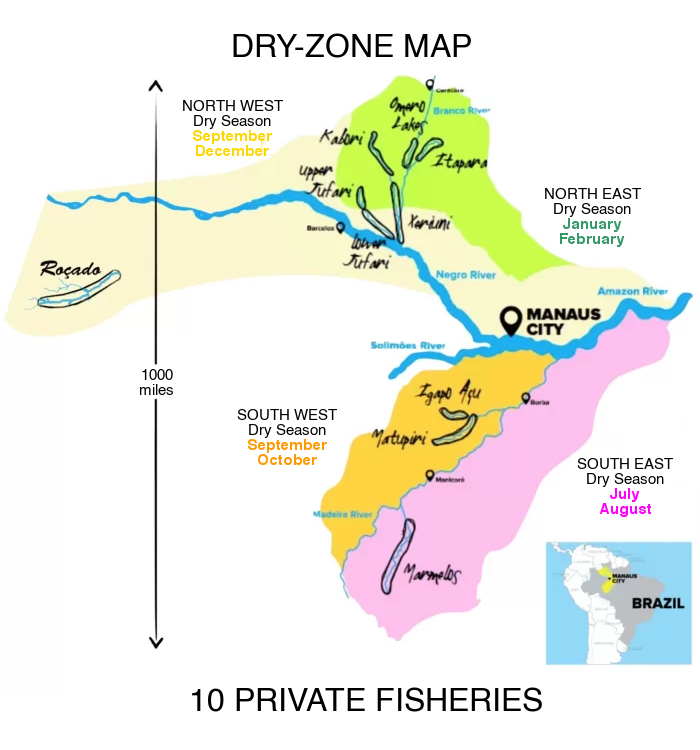
 Hopefully, the “dropping” water level indicated in the illustration will continue until our startup on January 5th. Alternately, we hope (and expect) the water level will at least stay the same. We base our expectation for good fishing on our 10-Day Rainfall Forecast (see below).
Hopefully, the “dropping” water level indicated in the illustration will continue until our startup on January 5th. Alternately, we hope (and expect) the water level will at least stay the same. We base our expectation for good fishing on our 10-Day Rainfall Forecast (see below).

Our 10-Day Rainfall Forecast starting Dec 29th is for the towns listed below in red which affect the zones mentioned. A 10-Day Forecast for more than 2 inches of rain means water levels may rise; under 2 inches means that water levels may drop.
Across much of the Amazon, rainfall forecasts are above the mentioned 2 inches, but the
- Caracarai: 1.79 inches (Marked as “Cca” in the map below)
- Boa Vista: 0.81 inches (Idem “Bvi”)
- Rorainopolis: 2.43 inches (Idem “Ror”)
- Barcelos: 2.04 inches (Idem "Bar")
3-Month Rain Anomaly Forecast In Our Four Fishing Dry Zones
(Valid for January-February-March)
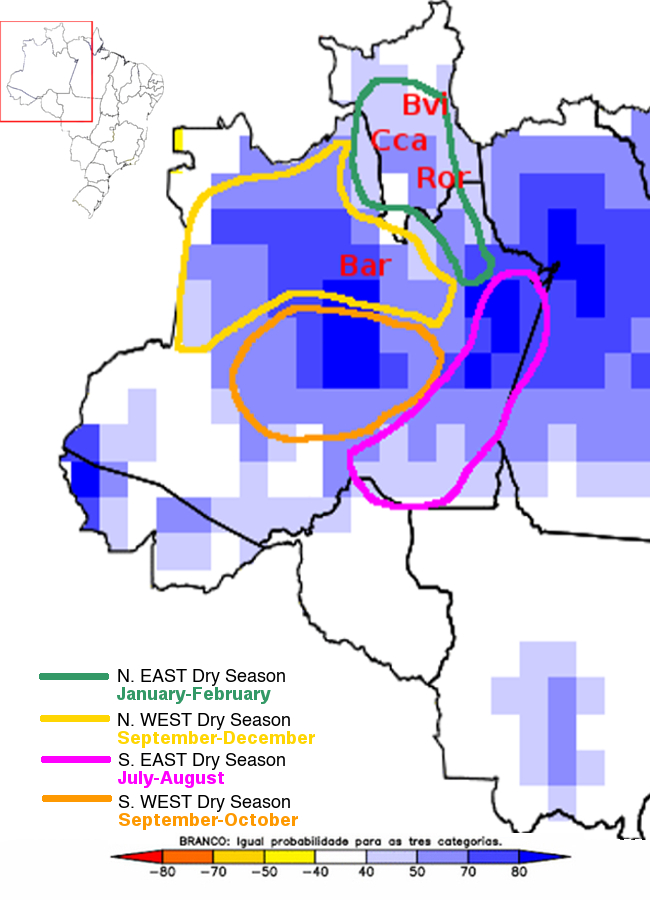
Source: CPTEC/INPE, Brazil
Our water-level predications are not just based on immediate rainfall forecasts but also on longer term (3-month) forecasts for unusual (or what is called anomalous) rainfall across all of our fishing zones. Note that the North East Zone, the zone with the lowest water levels, is in light blue meaning that it is expected to receive slightly more rainfall than normal for this time of the year.FR: October 29-November 5, 2022: Week 14
WE MOOOOVE….
4,050 Peacocks Out Of Remote Honey Holes
Five River Trains are now 500 miles North from where we started the season. Despite rising water levels everywhere, our 5 parties had good fishing.
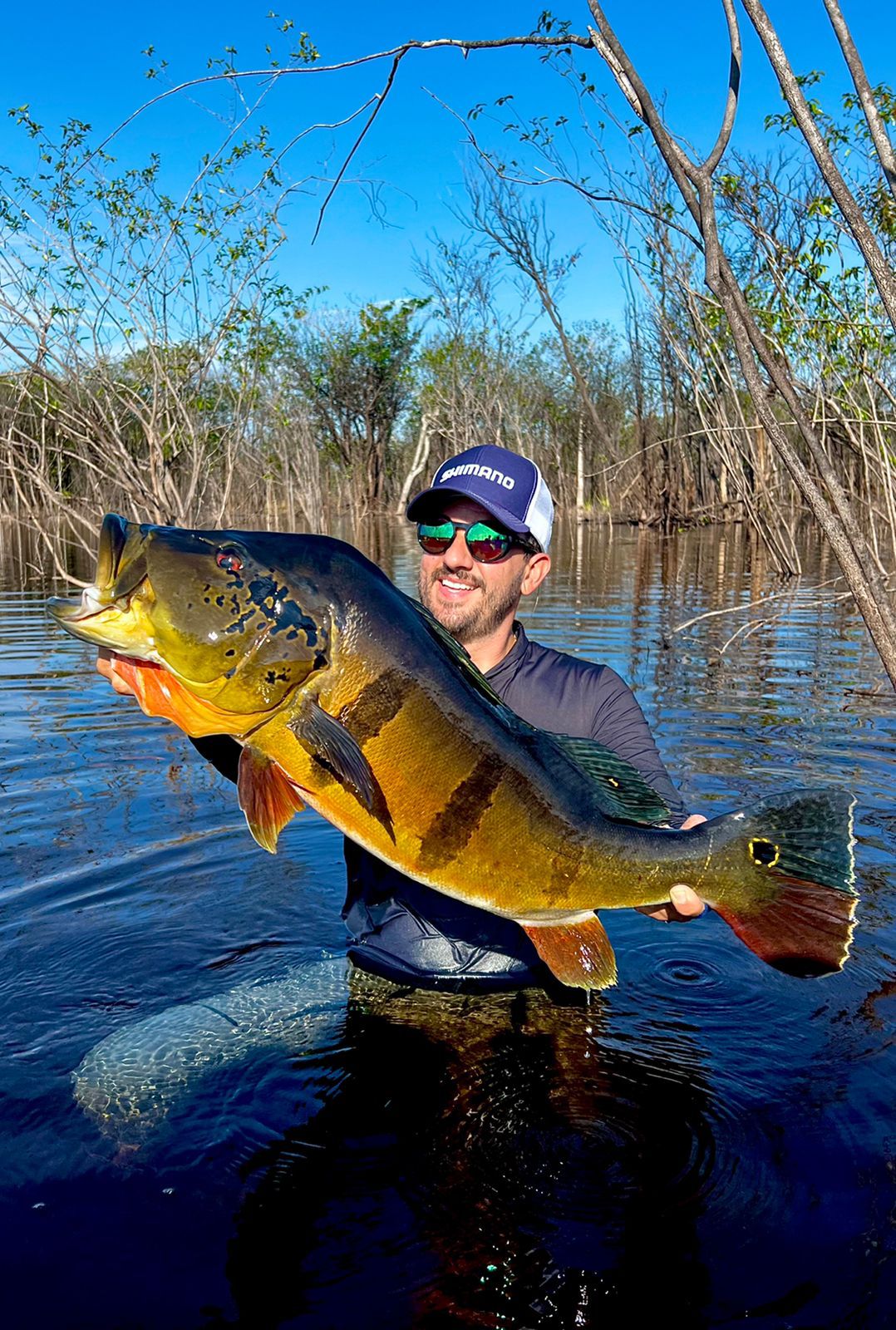
Stats: The total for the week was 4,050 peacocks caught by 40 anglers, divided in 5 parties/River Trains, of which 141 peacocks were between 10 and 16 lbs, 9 between 17 and 19 lbs, 7 between 20 and 22 lbs and the largest at 24 lbs. See the fish tally below, which excludes a wide array of other less aggressive tropical species, such as the arapaima, matrinchã, jacundá, apapá, wolfish, pacú, bicúda, red tail catfish and piranha.
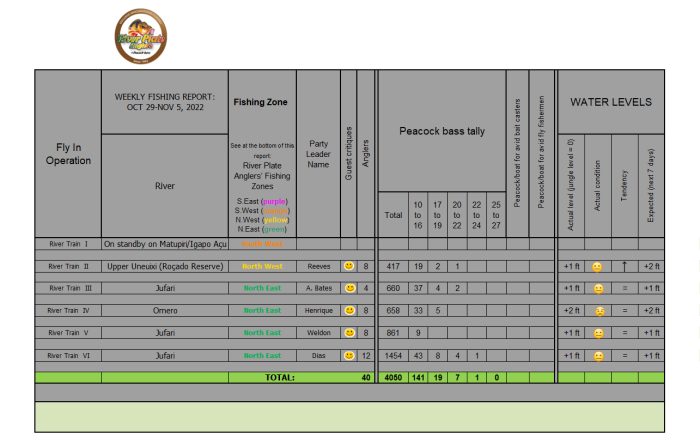 Click on the fishing tally to see it full size
Click on the fishing tally to see it full size
Guesswork: Expected water levels at our 10 Private Rivers spread out across 4 Dry Zones continue to be very predictable by taking carefully into account La Niña official forecasted rainfall changes.
In the North West Dry Zone (see Dry Zone map below) on the upper Uneuixi River (Roçado) water levels raised to unfishable levels for this week so we switched our arriving Hixon party 600 miles into the South West Dry Zone on the Matupiri & Igapo Açu with lower levels. See the water level drawing below. We will fish this area one or two weeks to see how the other Dry Zones 500-800 miles north play out.
 In the North East Dry Zone on the upper Jufaris water levels rose similarily during the week but, water levels 100km downriver presented good fishable conditions, as did also our Omero Lakes fishery. See below the water level drawing for both rivers. But the 10-Day Rainfall Forecast (see further below) is for little rain in this Dry Zone so we expect water levels drop during this week.
In the North East Dry Zone on the upper Jufaris water levels rose similarily during the week but, water levels 100km downriver presented good fishable conditions, as did also our Omero Lakes fishery. See below the water level drawing for both rivers. But the 10-Day Rainfall Forecast (see further below) is for little rain in this Dry Zone so we expect water levels drop during this week.


 In the North East Dry Zone on the upper Jufaris water levels rose similarily during the week but, water levels 100km downriver presented good fishable conditions, as did also our Omero Lakes fishery. See below the water level drawing for both rivers. But the 10-Day Rainfall Forecast (see further below) is for little rain in this Dry Zone so we expect water levels drop during this week.
In the North East Dry Zone on the upper Jufaris water levels rose similarily during the week but, water levels 100km downriver presented good fishable conditions, as did also our Omero Lakes fishery. See below the water level drawing for both rivers. But the 10-Day Rainfall Forecast (see further below) is for little rain in this Dry Zone so we expect water levels drop during this week.


We base our predictions based on the 10-Day Rainfall Forecast (accumulated inches). These forecasts are for the towns listed below in red which affect the zones mentioned. A 10-Day Forecast for more than 2 inches of rain means water levels may rise; under 2 inches means that water levels may drop.
Since the rainfall forecasts in our monitored towns in the North West Zone (Uneuixi) are over or just under 2 inches, we would expect water levels in zone to perhaps rise.
And, since in the North East Zone (Upper Jufaris, Omero etc) are just at 2 inches or less, we would expect water levels in these two zones to lower or maintain their levels.
On the other hand, since forecasts in the South West Zone towns are below 2 inches, we expect water levels to maintain the current low levels rising slightly.
The 10-Day Forecasts for the towns in the North West Zone are as follows:
- Villa Bitencourt: 2.91 inches (Marked as “VB” in the map below)
- Japura: 3.37 inches (Idem “Jap”)
- Santa Isabel do Rio Negro: 1.68 inches (Idem “SIR”)
- Sao Gabriel da Cachoeira: 1.76 inches (Idem “SGC”)
- Maraa: 1.43 inches (Idem “Mar”)
- Caracarai: 1.03 inches (Marked as “Cca” in the map below)
- Boavista: 0.91 inches (Idem “Bvi”)
- Rorainopolis: 1.59 inches (Idem “Ror”)
- Novo Airao: 1.07 inches (Idem "NoA")
- Barcelos: 0.76 inches (Idem "Bar")
- Borba: 1.03 inches (Marked as “Bba” in the map below)
- Novo Aripuana: 1.02 inches (Idem “NA”)
- Autazes: 0.78 inches (Idem “Aut”)
3-Month Rain Anomaly Forecast In Our Four Fishing Dry Zones
(Valid for November-December-January)
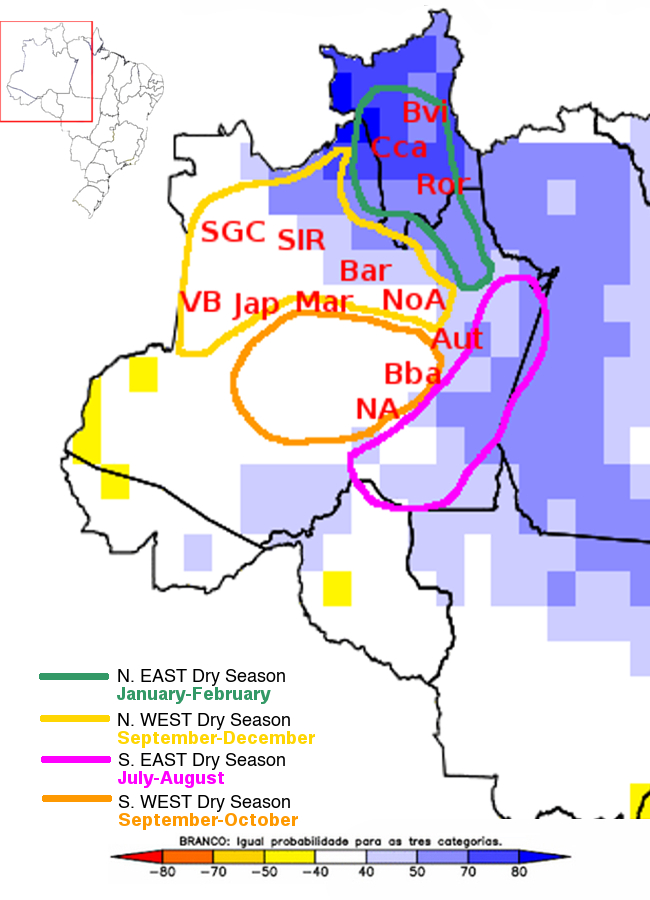
Source: CPTEC/INPE, Brazil
Our water-level predications are not just based on immediate rainfall forecasts but also on longer term (3-month) forecasts for unusual (or what is called anomalous) rainfall across all of our fishing zones. In the above illustration, no unusual rainfall is expected in the white areas for the next 3 months. Note that the North West Zone continues to be in light blue as it did last month, meaning that it is expected to receive more rainfall than normal for this time of the year. In contrast, the South West Zone is almost completely in white, meaning that it should receive the usual rainfall for this time of the year, which could be our FALL BACK to optimize good fishing during January and February in case our private fisheries in the North West Zone such as the Upper Itapara, Upper Xeurini and Upper Jufaris are above the good low water levels for that time of the year.
